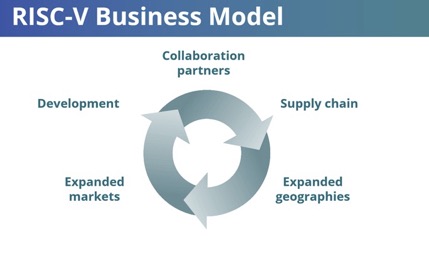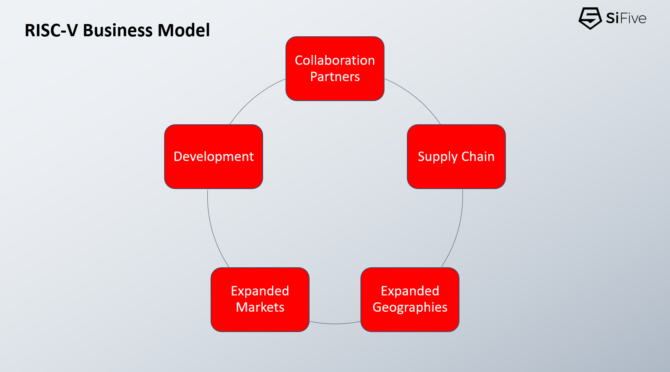
The growth of RISC-V across industries
By Dave Miller, head of corporate communications at SiFive
Electronics Semiconductors Wireless chips IP RISC-V processor semiconductor silicon wirelessAwaiting to see how RISC-V drives the new era of silicon design
RISC-V has seen significant momentum during the past year. According to RISC-V International there are over 10 billion RISC-V cores on the market, with thousands of engineers working on RISC-V initiatives around the world. Furthermore, nearly every semiconductor company has an active RISC-V implementation strategy. So, what’s driving this demand?
As computing requirements become more complex, there is a growing need for customized solutions. RISC-V offers unparalleled flexibility, extensibility, and scalability to optimize solutions for a wide variety of applications. In many cases RISC-V also offers significant high performance compute density (think small footprint and high efficiency). RISC-V’s modern, clean slate design allows companies to choose what extensions work best for a particular application and then tailor their designs to meet various requirements for power, performance, price, etc. And from a design standpoint there are broad solutions to work across your entire portfolio.

SiFive RISC-V biz model 72. Source: RISC-V International
RISC-V’s ecosystem is another major strength of the open instruction set architecture (ISA). Companies of all sizes are working together to add RISC-V support to many different technologies and tools. This kind of collaboration benefits everyone and makes silicon design more accessible. Widely taught in leading universities globally, it continues to expand, with more than 3,500 member companies a part of RISC-V International.
Many companies also appreciate that RISC-V helps to alleviate concerns of vendor lock-in. With proprietary architectures, companies are tying their product roadmap to one company’s future. Open architectures like RISC-V give companies more choice for IP providers and other solutions.
RISC-V will continue to transform the silicon industry in 2023 and beyond, opening up new opportunities for AI and ML applications, consumer products, datacenters, automotive use cases, and even aerospace. Let’s take a deeper look at why RISC-V adoption is growing in these segments.

Source: RISC-V International
AI & ML
Many of today’s embedded control processors lack the compute resources needed to execute inference workloads efficiently. Dedicated accelerators are an option, but they may not work well for modern neural networks and can be difficult to program. Additionally, in-house solutions can be expensive to maintain. With RISC-V, companies can create a better alternative, combining super high-performance control processors with scalable vector compute resources.
RISC-V vectors are powerful and super-efficient – in terms of code size, performance, and area – offering a compelling alternative to the inefficient use of packed-SIMD and GPUs for processing large datasets. The RISC-V Vector Extension (RVV) is small-in-size, with just a few hundred instructions, making it ideal for designs that require higher power efficiency and smaller memory footprints. Additionally, RVV is vector length agnostic, meaning software written for a RISC-V vector processor is compatible with other vector processors. All these benefits enable RISC-V vector solutions to simplify design cycles for AI and ML applications, giving companies greater design scalability and extensibility.
As a result, companies are turning to AI Dataflow Processors from companies like SiFive to efficiently manage these complex workloads and using RISC-V to offload or manage critical data and functions. Here again the performance and power efficiency bring strong benefits.
Consumer devices
Wearables, mobile phones, smart home devices, and AR/VR applications require processors that can handle demanding workloads but are also very efficient and compact. RISC-V vector solutions are a modern approach to help to address these requirements and enable companies to deliver higher compute density to consumer products. Additionally, the RISC-V Vector Cryptography extensions make it easier to bring secure and efficient cryptography to consumer devices. In just a few years, RISC-V Processors have power and performance that exceeds some of the most popular processors in the market today.
This past year, Google’s Android Open Source Project (AOSP) started the upstream enablement of RISC-V. This will help accelerate the development of a new wave of mobile devices, wearables, and other Android products based on the RISC-V architecture.
Datacenter
While there’s a common misconception that RISC-V is only used for microcontrollers, RISC-V is ideal for everything from tiny microcontrollers to super high performance computing solutions for datacenters. That’s because RISC-V gives companies complete design freedom. For datacenter applications, companies can optimize designs for super high performance and very low latency, while also adding custom instructions for specific workloads.
Automotive
The automotive market is rapidly changing as we’re seeing a centralization of computing, increased compute at the sensing edge, and increased software complexity due to mixed criticality support. Additionally, there’s been a shift from domain architectures to more efficient zonal controllers. This is driving a need for more capable electronic control units (ECUs) with a higher degree of mixed criticality functional integration into fewer devices.
RISC-V automotive solutions make it possible for manufacturers to customize solutions far more than they would with other CPU vendors to meet the latest market requirements. As a result, Counterpoint Research estimates that RISC-V will be in 10% of cars by 2025. We anticipate that adoption of RISC-V in the automotive market will surge far higher in the following year as ISO certified and automotive ready RISC-V designs find use in safety, infotainment, ADAS, and autonomous and electric automotive innovations.
Aerospace
The power efficiency, fault tolerance, and compute flexibility of RISC-V solutions is perfect for aerospace applications. For example, NASA is using RISC-V cores, to deliver 100x the computational capability of today’s space computers for planetary and surface missions. In rigorous head-to-head testing RISC-V showed its competitiveness with existing solutions. This boost in computing performance will drive new kinds of innovations for autonomous rovers, vision processing, space flight, guidance systems, and communications.
In addition to the technical benefits of RISC-V, aerospace organizations recognize the value of having a vibrant global ecosystem that is designing with RISC-V. The open and collaborative nature of RISC-V allows the academic and scientific software development community to contribute and develop scientific applications and algorithms for RISC-V software, in addition to optimizing math functions, filters, transforms, neural net libraries, and other software libraries for RISC-V applications. This was a key part of the vision of our pioneer founders. Since aerospace processors can be in use for decades, it’s critical that the ecosystem for an architecture will stand the test of time.
With billions of RISC-V cores on the market today and the surging demand for RISC-V across a wide range of applications, it’s become clear that RISC-V truly has no limits. We look forward to seeing how RISC-V drives this new era of silicon design.
————————————————-
SiFive Inc. is a fabless semiconductor company and provider of commercial RISC-V processor IP and silicon chips. https://www.sifive.com
RISC-V International is the non-profit home of the open standard RISC-V Instruction Set Architecture (ISA), related specifications and stakeholder community. More than 3,180 RISC-V members across 70 countries contribute and collaborate to define RISC-V open specifications.
